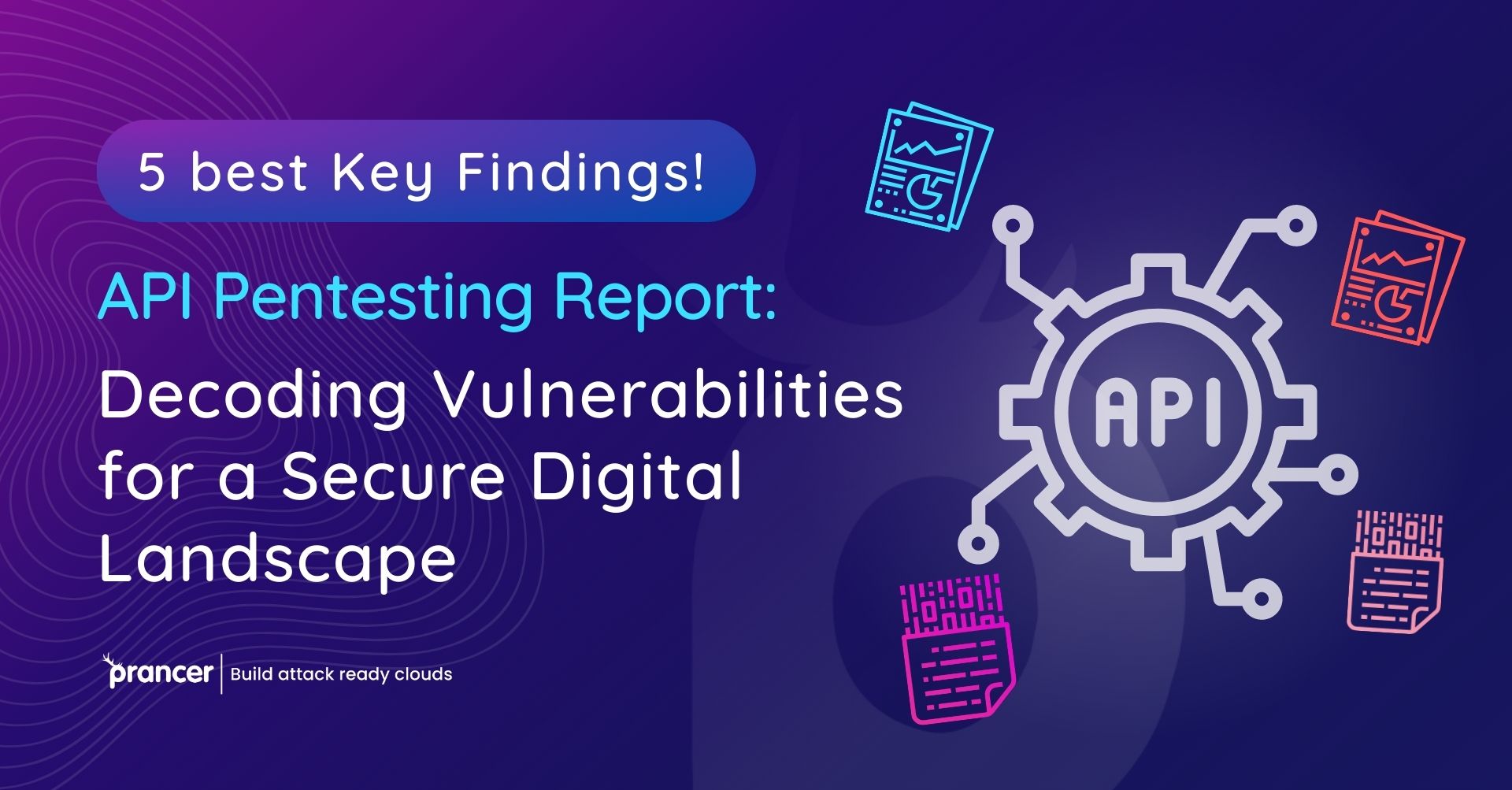

In the age of digital transformation, where the security of APIs (Application Programming Interfaces) is paramount, the API Pentesting Report has become an essential tool. It helps reveal vulnerabilities within APIs, paving the way to bolster digital defenses. This blog will delve into the vital findings and notably, how Prancer’s innovative approach, including automated penetration testing, leads to a robust and secure digital environment.
The API Pentesting Report is not only a diagnostic tool but an invaluable guide for cybersecurity professionals. Using simulated real-world attacks, this report exposes weaknesses and introduces potential risks. Knowing the results allows organizations to take specific steps in protecting their APIs.
The context for the API Pentesting Report brings forth Prancer as a guiding force in developing more secure APIs. Prancer’s powerful cloud security platform allows organizations to substitute automated API pentesting for undiscovered holes. With the help of automated penetration testing, Prancer shortens test time without compromising quality; this allows organizations to rapidly detect vulnerabilities.
In addition to automated penetration testing, API security lies in Prancer’s hands. Prancer’s API pentesting procedures have been simplified in order to achieve adequate identification and elimination of vulnerabilities. Its hybrid strategy also pinpoints crucial weaknesses, reinforcing digital defenses and designing a safe space for APIs.
In today’s digital age, keeping API security strong is very important. That’s why the report on testing APIs for safety would be a big help in protecting our computer connections and networks from harm or attack. This important report helps with cybersecurity study. It finds weaknesses in APIs, letting companies improve their computer safety. It uses pretend attacks to show weak areas, helping in direct safety moves. Some key problems that are often noticed include mistakes with authentication, not enough checking of input data, exposure of private details, and weak rate limits. Also insecure references to direct objects. Prancer’s new way of testing APIs automatically changes how it happens. Prancer helps find security gaps quickly using automated testing but doesn’t lose quality. This helps to quickly and strongly protect APIs, improving all digital safety while keeping the trust in API systems. Prancer’s job in testing APIs is very important. It helps find and fix weaknesses easily, making a safer online world better protected from danger.
In the modern era of digital world where APIs are key to online integration, Automated Penetration Testing is assuming critical importance in securing these interfaces. API Pentesting Report, coupled with Prancer’s automated approach to testing has proven to be a vital resource in detecting and mitigating these vulnerabilities. This elaborate exposition shall expose the insights surrounding API Pentesting Reports and how Prancer’s APT offers a secure digital space.
Automated Penetration Testing: Revolutionizing API Security
APT is transforming the philosophy of cybersecurity, especially when it comes to API security. Through the use of advanced algorithms and artificial intelligence by APT, cyber attacks are simulated to expose possible risks in APIs providing a level of accuracy that traditional techniques cannot achieve.
Understanding the API Pentesting Report
An API Pentesting Report is a detailed analysis of the positives and negatives when it comes to They are important tools in the hands of cybersecurity professionals, as they shed lights on what should be done to strengthen digital defences.
Significant Components of the API Pentesting Report
Authentication and Authorization Vulnerabilities: One of the frequently observed shortcomings in these reports is also the lack of appropriate means to prevent illegal access, which seems crucial for safeguarding confidential data.
Input Validation Deficiencies: Incomplete input validation enables several injection attacks. Improving this attribute is key to preventing unauthorized code executions.
Sensitive Information Exposure: A common problem is the exposure of API keys or credentials, thereby showing that there has been a reduced way in which data preservation occurs.
Lack of Rate Limiting: However, the lack of rate limiting is frequently panned because API availability in receiving services can be compromised by denial-of-service attacks.
Insecure Direct Object References: Notably, weak direct references are often noted in reports showing the need for strong access controls.
Prancer’s Automated API Pentesting Approach
Prancer has revolutionized API pentesting through automation. This innovation greatly reduces the time needed to analyze while not losing quality of analysis. The APT used by Prancer quickly detects vulnerabilities because it addresses them immediately and efficiently.
Prancer and enhanced API security
The approach that Prancer uses for API pentesting stands out due to the combination of automated testing and skills-based analysis. This two-pronged approach not only detects vulnerabilities but also offers one complete solution to their elimination.
API Security Impact of Automated Penetration Testing
APT is reshaping API security. Its ability to quickly and precisely detect vulnerabilities allows organizations to prevent the attacks of diverse cyber threats from their APIs.
That is why the future of API security through APT can be discussed below.
With evolving global cybersecurity threats, APT will continue to be an essential element in API protection. It is through its adaptability and learning capabilities that the system has been able to respond effectively to cyber threats in a dynamic nature.
Significance of APT in API Security
APT is escalated best once teams are made aware of its benefits and way round. APT aclarity across different departments ensures uniform and functional security plan.
Trust in API Systems via APT.
Trust is established by the security of API systems. APT is critical in achieving this trust since it provides complete testing and API security.
What is Prancer’s vision of the future for API Security?
They constantly improve the APT processes while striving to lead API security innovation. This insistence on progress defines new standards in this field.
APT integration into Organizational Security Cultures
APT integration into organization’s security culture is an essential step towards increasing its efficiency. Comprehensive knowledge of APT by all involved parties is the necessary pre-requisite for its effective use in securing APIs.
Prancer’s APT Advantages in Rapid Vulnerability Detection
However, the feature that distinguishes Prancer’s APT is its ability to quickly detect potential security gaps. This allows organizations to respond immediately and retain integrity of API systems as well as trust worthiness in these processes.
Proactive Cyber Defense – Prancer’s Contribution
With its cutting-edge APT solutions, Prancer enables organizations to take a proactive approach towards cybersecurity by discovering and mitigating vulnerabilities before hackers can use them.
APT as a transformative tool in cybersecurity.
APT does not serve as an auxiliary element of cybersecurity strategies; however, it becomes a transformative tool that changes the approach to digital security especially in respect of APIs.
The Increasing Role of APT in Cybersecurity.
And while the digital interactions still rely on APIs, APT will become more and This therefore means that APT is a priceless resource in the struggle to secure digital systems.
Automated Penetration Testing: A Key to API Resilience
APT comes out as a leading force in strengthening API reliability, providing more effective, accurate and all-encompassing way to security testing With organizations such as Prancer leading the way, APT is poised to become a crucial aspect of cyber security.
The API Pentesting report arises as an important tool in the path to robust API security. Leveraging Prancer’s insight and integrating its leading edge technology, including automated penetration testing–these are ways in which organizations can forge a defensible digital space. Whether you are a veteran cybersecurity pro or just starting on the path of API security, Prancer will be your roadmap to protecting digital assets as growing threats continue to expand their attacks.
